AMD Launches Mobile Kaveri APUs
by Jarred Walton on June 4, 2014 12:01 AM ESTAMD Kaveri FX-7600P GPU Performance Preview
Given the 3DMark results we just showed as well as the increase in CPU performance, I was very interested to see what Kaveri could do in terms of gaming performance. Here I have to temper my comments somewhat by simply noting that the graphics drivers on the prototype laptops did not appear to be fully optimized. One game in particular that I tested (Batman: Arkham Origins) seemed to struggle more than I expected, and there are other games (Metro: Last Light and Company of Heroes 2) that will bring anything short of a mainstream dGPU to its knees. I've posted the Kaveri Mainstream and Enthusiast scores in Mobile Bench, but they're not particularly useful as most of the scores are below 30 FPS. Here, I'll focus on our "Value" settings, which are actually still quite nice looking (Medium detail in most games).
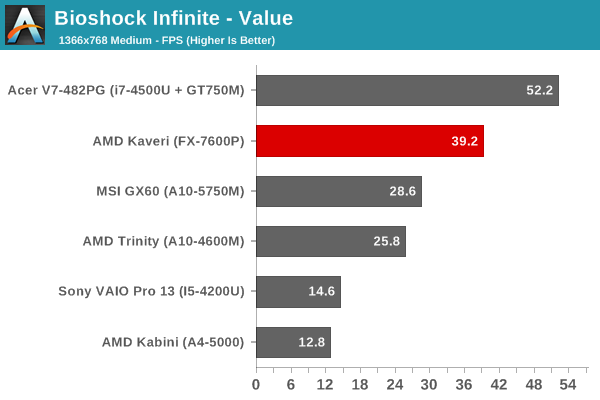
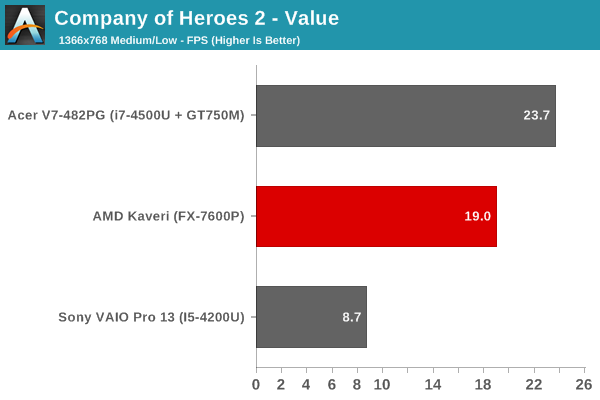
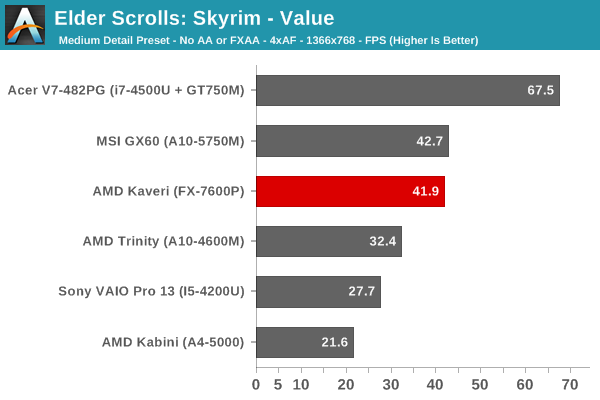
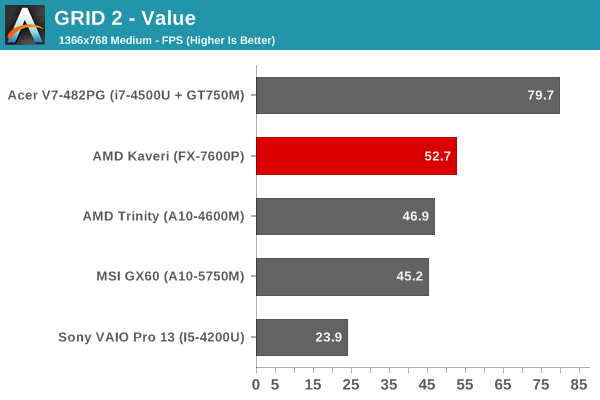

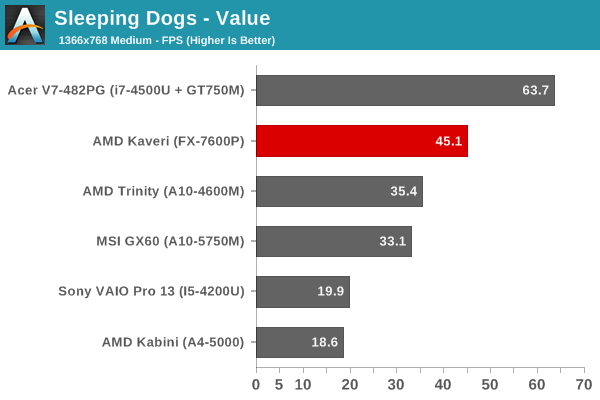
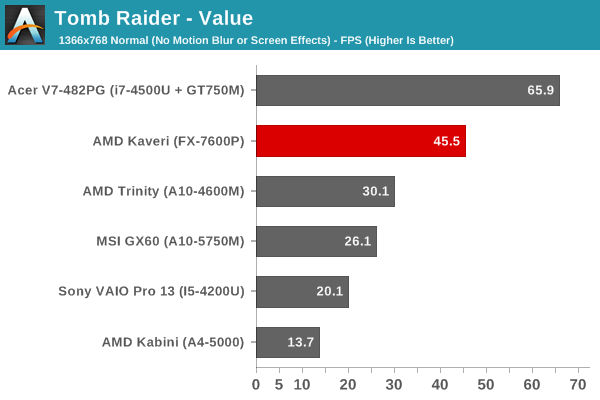
As expected, in most of the tests the Kaveri APU is able to surpass the gaming performance of every other iGPU, and in some cases it even comes moderately close to a discrete mainstream dGPU. There's a sizeable gap between the Trinity/Richland APUs and Kaveri in most of the games I tested, which is great news for those looking for a laptop that won't break the bank but can still run most modern games.
Getting into the particulars, Skyrim seems to be hitting some bottleneck (possibly CPU, though even then I'd expect Kaveri to be faster than Richland), but the vast majority of games should run at more than 30 FPS. There was one system with a pre-release Mantle driver installed that was running Battlefield 4 reasonably well at low/medium details, and with shipping laptops and drivers (and perhaps DDR3-2133 RAM) I suspect even Metro might get close to 30 FPS. Of course, we're only looking at the top performance FX-7600P here, so we'll have to see what the various 19W APUs are able to manage in similar tests.










125 Comments
View All Comments
Roland00Address - Wednesday, June 4, 2014 - link
It turbos but not as well as IntelGalatian - Wednesday, June 4, 2014 - link
And because Intel is able to implement a better turbo they are somehow cheating? I mean it still is a advantage for the consumer in the end. Race to idle and all.zaza991988 - Thursday, June 5, 2014 - link
Actually sometimes Turbo helps with the overall energy efficiency. Turbo enable to push the CPU to the limit and finish the high demanding task quickly so it can return into a lower power state afterwards. So you are temporarily increasing the instantaneous power to get a better an overall energy efficiency.sspiff - Wednesday, June 4, 2014 - link
The TDP of AMD's offering includes the much more powerful GPU (compared to Intel's HD4400 in the i7). For the benchmark results, the Intel was paired with a discrete nVidia card (750M), which also guzzles power NOT included in the 15W TDP of the i7.I'm not familiar with what other parts are on-/off-die for these CPU's, but it's not fair to compare the power envelopes on a spec sheet like you're doing. The fair test would be to measure full-system power consumption of two comparable devices, which is sadly not possible at this time, as no Kaveri laptops have shipped yet.
Torashin - Wednesday, June 4, 2014 - link
Remember power consumption increases exponentially with frequency, and this phenomena is even more accentuated with Kaveri because of the process used. So what I'm saying is that the 19W APU's likely wouldn't be that much slower than the 35W one.Drumsticks - Wednesday, June 4, 2014 - link
Maybe its also true of frequency, but I believe you're looking for voltage. Power consumption for two different frequencies at the same voltage is much different than two voltages at the same frequency.I could be wrong, though.
JumpingJack - Wednesday, June 4, 2014 - link
Buzzzzz, wrong. Power = C*f*(V^2), power is linear with respect to frequency and quadratic with respect to voltage. (C is effective capacitance). Google "Power CMOS Circuits".zaza991988 - Thursday, June 5, 2014 - link
Actually the relation between power and frequency is linear. The relation between the power and voltage is quadratic. p = c*f*v^2. and a higher TDP allows the CPU to stay at a higher performance state for a larger amount of time. you can compare the performance between a 15 watt TDP and 28 watt TDP in the following link. (rMBP 13 has 28 TDP ship and air has 15 or 17)http://www.notebookcheck.net/Review-Apple-MacBook-...
eanazag - Wednesday, June 4, 2014 - link
Close compared to the i7 ULV and GT 750. Often better than the i5. It is good against what will likely cost at least $100 to $200 more. Battery life that is 80% and weight that is 110% of those Intel machines might be a reasonable trade off saving $200.Dan Ritchie - Wednesday, June 4, 2014 - link
On other sites (with slides) they're comparing the 19 watt part against the 15 watt part, not the 35 watt part.